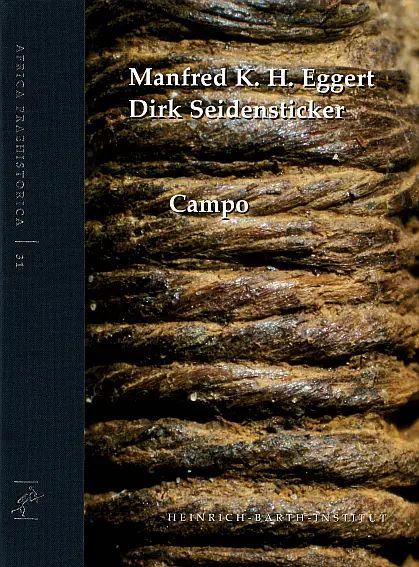- Autor/in:
- Author:
- Manfred K. H. Eggert, & Dirk Seidensticker
- Mit Beiträgen von:
- With contributions by:
- Christophe Mbida Mindzié, Conny Meister, Antoine Mvondo Ze, Pascal Roger Nlend Nlend & Stephan Ritter
- Erscheinungsjahr:
- Publication year:
- 2016
- Reihe & Band:
- Series & Number:
- Africa Praehistorica 31
- ISBN:
- ISBN:
- 978-3-927688-43-8
- DOI:
- DOI:
- 10.18716/hbi/ap31
- Preis:
- Price:
- 38 € Aktuell: 5 €
- 38 € Discount price: 5 €
Die archäologischen Stätten von Campo, einer kleinen Stadt an der Grenze zwischen Kamerun und Äquatorialguinea, wurden im Jahr 2000 von einem französisch-kamerunischen Team entdeckt. Die Hauptausgrabungsstätte bei der katholischen Kirche wurde durch Bulldozer und Erosion stark beschädigt. Systematische Ausgrabungen wurden schließlich im Februar und März sowie im Juni und Juli 2007 von einem deutsch-kamerunischen Team durchgeführt. Dabei wurden zwei Befunde in der Nähe der Kirche und elf Befunde in der Kirche selbst ausgegraben. Darüber hinaus wurde ein umfangreicher Survey in verschiedenen Bereichen der Stadt durchgeführt. Mit Ausnahme von zwei tiefen Gruben handelte es sich bei allen anderen Strukturen um Bestattungen. Von besonderem Interesse war die rechteckige Anordnung der Befunde, die reichlich mit Keramik und vor allem mit einer Vielzahl von Eisenwerkzeugen, Waffen, Ringen und Armreifen ausgestattet waren. Die Anordnung von Keramikgefäßen und Eisenobjekten deutet darauf hin, dass es sich bei den Befunden um Bestattungen handelt. Aufgrund des Säuregehalts der tropischen Böden ist es nicht verwunderlich, dass bei den Ausgrabungen kein Skelettmaterial gefunden wurde. Die Untersuchungen in Campo ergaben 40 Radiokarbondaten. Sie decken einen Zeitraum vom 4. Jahrhundert v. Chr. bis zum 13. Jahrhundert n. Chr. ab. Der Großteil der Daten fällt in die erste Hälfte des ersten Jahrtausends n. Chr. und stammt hauptsächlich aus den Bestattungen. Die beeindruckende Anzahl der verschiedenen Klassen von Eisenobjekten führte zu einem ausgedehnten Projekt zur Vorbereitung, Konservierung und Restaurierung. Es wurde im
The archaeological sites of Campo, a small town on the border between Cameroon and Equatorial Guinean, were discovered in 2000 by a French-Cameroonian team. Due to bulldozer leveling and erosion, the main site, situated at the Catholic church, was severely damaged. Systematic excavations were finally realized in February and March and in June and July of 2007 by a German-Cameroonian team. During these activities two features at a site situated in the vicinity of and eleven features at the church itself were excavated. Moreover, an extended survey was conducted in different areas of the town. Except for two deep pits, all other structures represented burials. Of special interest was the rectangular layout of features that were richly furnished with ceramics and, most remarkably, with a wide range of iron tools, weapons, rings and bracelets. The layout and arrangement of ceramic vessels and iron objects suggested that the features represented burials. Due to the acidity of tropical soils it is not surprising that no skeletal material was encountered during the excavation. The research in Campo provided a body of 40 radiocarbon dates. They cover a timespan from the 4th century BC through the 13th century AD. The majority of the dates falls within the first half of the first millennium AD and originates mainly from the burials. The impressive number of different classes of iron objects led to an extended project of preparation, conservation and restoration. It was realized in the laboratories of the Römisch-Germanisches Zentralmuseum in Mainz-on-Rhine from 2008 to 2012. The whole complex to be dealt with amounted to about 200 items which included some large blocks of hard sediment containing iron objects. Wherever possible, fragments of objects were fitted together during the process of restoration. With regard to the ceramics excavated in the context of burials in Campo, it is made up mainly of open bowls. The formal homogeneity of the vessels and temporal coherence argues for the creation of a new ceramic style group.

